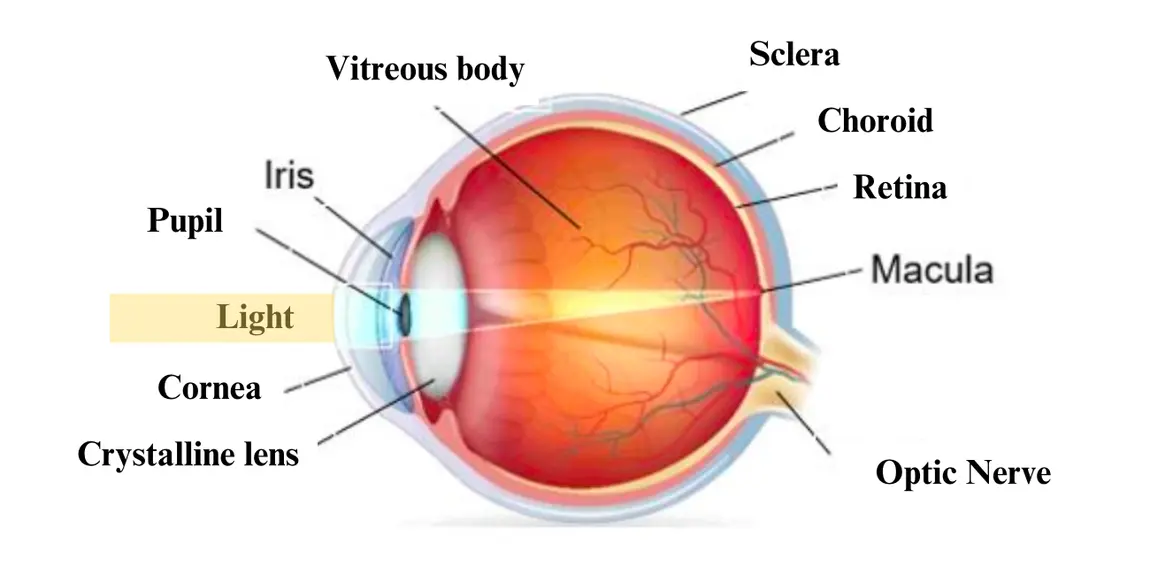Exploring Gender Differences in Age-Related Macular Degeneration (AMD)
GAMD is a progressive eye disease affecting millions of people worldwide. Although AMD is known to be more common in older people, it is possible to determine whether gender influences the progression and treatment of AMD.

Understanding AMD
AMD is a degenerative disease that affects the macula, a small area of the retina responsible for central vision and the perception of fine detail. AMD is the leading cause of vision loss in people over 50. It is divided into two main forms: dry AMD, which progresses slowly, and wet AMD, which is more severe and progresses rapidly. Common risk factors for AMD include age, heredity, smoking, exposure to ultraviolet radiation, a diet low in antioxidants and certain cardiovascular problems.

Figure 1. Anatomy of the human eye
We have published another article where you can learn more about AMD and its risk factors.
Gender Differences in AMD Prevalence
Research suggests that AMD is slightly more prevalent in women than in men, although the observed difference is relatively small. This finding raises questions about the factors that might contribute to this disparity. Several factors may influence these gender differences, including genetic variations, hormonal factors and environmental factors.

Figure 2. AMD is slightly more prevalent in women than in men.
Who is at high risk for AMD?
- Advanced age is the most significant risk factor for AMD.
- Other risk factors include family history, smoking, obesity, high blood pressure, and certain genetic variations.
- Women have a slightly higher risk due to factors like longevity and hormonal changes associated with menopause.
Gender-Specific Factors and Disease Progression
Hormonal factors :
Estrogen, a hormone more prevalent in women, may play a protective role against the development of AMD. However, studies suggest that hormonal changes during menopause, particularly the decrease in estrogen levels, may contribute to an increased risk of AMD. Thus, lower estrogen levels may diminish the protective effects, potentially making women more vulnerable to the disease.
Genetic Variations :
Genes influence AMD, and certain genetic differences affect the disease differently in men and women. Ongoing research aims to find gender-specific genetic markers that impact the progression of AMD. These markers can provide insights into the biological processes of AMD and guide personalized treatments based on gender-specific factors. Understanding these genetic variations will enhance our understanding of AMD and lead to targeted interventions for this vision-threatening condition.

Figure 3. Sex-linked genetic markers that affect how AMD progresses.
You can explore our additional article that delves deeper into AMD and Genetic, providing further insights and knowledge on the subject.
Treatment Response and Gender-Specific Healthcare
Research suggests that there are gender variations in the progression of AMD and in how individuals respond to treatment. However, further research is needed to fully grasp the significance of gender-specific treatment strategies.
To fully understand AMD and its gender-related aspects, it is essential to include both sexes in epidemiological studies and clinical trials. By recognizing gender-specific factors, healthcare professionals can provide personalized care for people with AMD, taking gender-related risk factors and treatment responses into account when managing the patient.
Conclusion
AMD is a complex eye condition with multifactorial causes and implications. While gender differences exist in the prevalence, risk factors, and potential treatment response of AMD, further research is needed to fully understand these nuances. By exploring gender-specific factors, conducting comprehensive studies, and implementing gender-responsive healthcare, we can work towards optimizing AMD prevention, management, and treatment outcomes for all individuals.
You can also have access to personalized lifestyle recommendations to prevent AMD by visiting www.macutest.com.
Bibliography
- « Age-Related Macular Degeneration (AMD) | National Eye Institute » .
- *What Is Macular Degeneration ?* (2023, 6 avril). American Academy of Ophthalmology.
- A. R. Rudnicka, Z. Jarrar, R. Wormald, D. G. Cook, A. E. Fletcher, et C. G. Owen, « Age and Gender Variations in Age-related Macular Degeneration Prevalence in Populations of European Ancestry : A Meta-analysis » , Ophthalmology, mars 2012
- « Overview of Risk Factors for Age-Related Macular Degeneration (AMD) » , PubMed, 2015.
- R. Nuzzi, S. Scalabrin, A. Becco, et G. Panzica, « Gonadal Hormones and Retinal Disorders : A Review » , Frontiers in Endocrinology,mars 2018
- M. Sasaki et al., « Gender-specific association of early age-related macular degeneration with systemic and genetic factors in a Japanese population » , Scientific Reports, janv. 2018.
- A. I. Marin et al., « Sex and Age-Related Differences in Complement Factors Among Patients With Intermediate Age-Related Macular Degeneration » , Translational Vision Science & Technology, mai 2022.
- « Genetics and Age-Related Macular Degeneration » , American Academy of Ophthalmology, 17 mars 2023.
- N. Lambert et al., « Risk factors and biomarkers of age-related macular degeneration » , Progress in Retinal and Eye Research, sept. 2016.
- M. Zetterberg, « Age-related eye disease and gender » , Maturitas, janv. 2016.
The link Between Age-related macular degeneration (AMD) and Ethnicity.
Genetics has the power to unlock the mysteries of our physical traits, our predisposition to disease and even our evolutionary history. In fact, AMD is caused by genetic factors and environmental. AMD is a leading cause of vision loss and blindness, particularly among the elderly population. While various factors contribute to the development and progression of AMD, emerging research suggests that ethnicity may also play a role in influencing the risk and characteristics of the disease.
The impact of pollution on Age related macular Degeneration (AMD)
Increasing environmental pollution is leading to growing concern about its effects on human health. Among pollution-related health problems, AMD is emerging as a major concern. Recent studies suggest a potential link between exposure to pollution and the development or aggravation of AMD.